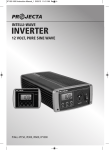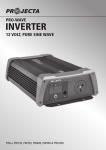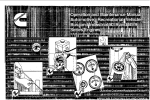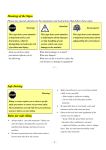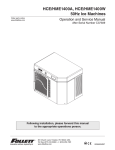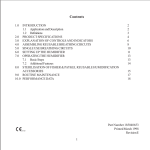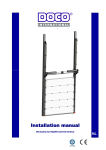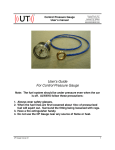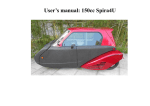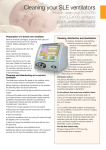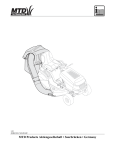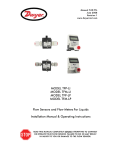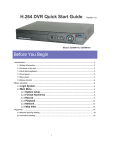Download Untitled - Highlift Auto Services
Transcript
Gauges What do they mean? Welcome to Highlift Auto Service’s Car Care Clinic. During this clinic we would like to educate you on the basics of car care. What you are about to learn may sound simple but is very important if you are going to be driving. We want you, the driver, to feel comfortable and confident doing basic maintenance, anything from topping up the windshield washer fluid to changing a flat tire. The more you know, the more confident a driver you are. Please feel free to stop us at anytime to ask questions. Every question is important and brings you one step closer to understanding your car. 1. ba sic m a int en a nce Car Maintenance What is it and why is it important? Car maintenance is preventative and less expensive in the long run. It is seeing a problem and fixing it before rather than after. All vehicle manufactures include in the owner’s manual* a list of maintenance recommended for your specific vehicle. This list includes oil changes, spark plug replacement, general tune-ups, etc. The list may vary depending upon specific driving conditions such as cold weather. Your vehicle has many different gauges, each mean something different. These gauges are a link to what is happening under the hood. Tachometer: This shows how fast your engine is running (RPM). Speedometer: This shows how fast you are travelling. Posted speed limits are for ideal travelling. Remember to always slow down in bad weather. (Fog, heavy rain, snow, ice, etc…) Oil Pressure: This represents the oil supply to your engine. When the oil pressure is too low it could cause engine damage. You should immediately check your oil and call your service technician. High oil pressure is not common. It could mean that you have the wrong type of oil in your vehicle or other problems. Again, you should call your service technician. Fuel Gauge: This gauge tells you the fuel level in your tank. When the weather is cold, it is not recommended to let your tank get below half because of condensation problems. Engine/Coolant Temperature: This gauge represents your engine temperature. A vehicle that is overheating should be shut off and allowed to cool down. A cold engine will not produce the heat in the winter and is harder on fuel consumption. Normal temperature runs around the center of the gauge. What should you do if your car overheats? REMEMBER: Check for burnt out headlights and brake lights on a regular basis. 2 Shut the vehicle off immediately and contact your service technician. HANDS-ON CAR CARE CLINIC Fluid Levels Voltage Gauge (charging gauge): This gauge represents the electrical system. It shows what your battery power is and what the alternator is producing. On a vehicle that is running the gauge should read 13.0V to 14.7V approximately. If this reads too low or too high you need to contact your service technician. Warning lights What do they mean? Warning lights are alerting you to a problem. They are not to be ignored. When a new light appears you should first, consult your owner’s manual* then bring your vehicle to a service technician for a diagnostic check. Below are a few examples of warning lights and what they mean. Check engine: There is a problem with the vehicle’s engine electrical system or sensors and should be addressed immediately. Fuel light: This light lets you know that your fuel level is getting low. Windshield washer fluid light: This light lets you know that your washer fluid is low. Oil pressure light: This light indicates that you are running low on oil. You need to top up your level immediately or engine damage might occur. You should always top up your engine with the recommended oil or call your service technician. Change oil light: This light indicates that an oil change is overdue. Security/Anti-theft light: This indicates a problem with your anti-theft system. COMPLIMENTS OF HIGHLIFT AUTO SERVICE Why to check them and their importance. Antifreeze: Antifreeze should only be checked on a cold engine to prevent burns when the engine is hot. Consult your owner’s manual* for specific levels. Windshield washer fluid: In the cold weather you need winter washer fluid, generally -40˚c. In the summer you can use a fluid that has a detergent in it to remove bugs. By using the proper fluid you will be ensuring good visibility through your windshield at all times. Never let your fluid run out and carry a spare jug with you at all times. Oil: Oil should be checked with the engine shut off and sitting on a level surface. Always bring the dipstick out, wipe clean, and then check the level. If you do not, the level will not be accurate. Brake fluid: A visual check of the reservoir can be done. Consult your owner’s manual* for recommended brake fluid. ONLY USE APPROVED BRAKE FLUID FOR YOUR BRAKE SYSTEM. Transmission fluid: An automatic transmission can be checked on most vehicles with the engine running with park brake applied. Consult your owner’s manual* for proper level and to see whether your vehicle needs to be in park or neutral. A manual transmission has to be checked by a service technician with your vehicle on a hoist. NOTE: Fluid levels listed above are checked routinely during oil changes. An oil change is generally recommended every 3 months or every 5000 kilometers, whichever comes first. 3 2. t ire m a int en a nce How to change a flat tire A flat tire should be changed on a level surface whenever possible and always with the park brake applied. Consult your owner’s manual* for proper procedure and location of spare tire and tools. A demonstration will be provided during the clinic as well as a hands-on opportunity to change a tire. How to measure tire pressure In order to properly measure tire pressure you need a tire pressure gauge. Remove valve stem cover and put tire pressure gauge squarely on the valve stem to provide an air tight seal. The gauge will indicate tire pressure. What is your vehicle’s ideal tire pressure? Most passenger vehicles start at 32psi approximately. For your vehicle’s specific tire pressure consult your owner’s manual*. Never exceed recommended pressure indicated on tire. How to put air in your tires Remove valve stem cover and add air in small increments rechecking tire pressure frequently. There will be a demonstration provided as well as a hands-on opportunity. Winter versus all season What is the difference in tires? Winter tires are made for winteR Winter tires contain a softer rubber compound making them grip the ice and snow better in cold weather. One misunderstanding people have is that winter tires are for snow. The fact is that once the temperature gets below 5C winter tires begin to outshine all-season tires. Winter tires have tread patterns and rubber compounds engineered for cold conditions. With a winter tire you can improve braking by 25% and handling by 38%. You need 4 winter tires to maintain vehicle handling and balance. All seasons are for spring, summer, and fall WARNING: Underinflated tires can cause a tire to overheat and blow out. They contain a harder rubber compound making them grip better during the warmer weather. For winter driving in New Brunswick all-season tires aren’t the best answer, they are a compromise. When the temperature drops, they get too hard to grip ice and snow. Does the weather make a difference in your ideal tire pressure? Cold weather condenses air which lowers tire pressure to the point it may be underinflated. Hot weather expands air which increases tire pressure. Tire pressure should be checked monthly and during extreme temperature changes. 4 REMEMBER: Retorque your wheels within 100km of a tire change to prevent a loose wheel. HANDS-ON CAR CARE CLINIC 3. oil ch a nge s 5. se asonal Why change the oil? An engine produces contaminates that shorten engine life. Good quality oil contains a detergent that cleans your engine. When you do an oil change you remove the dirty oil and replace it with new oil. This continues to keep your engine clean. Oil changes are also a good way of doing preventative maintenance. A good service technician will also check fluid levels during an oil change. 4. bat t ery What you should do at the change of seasons A general tune-up is recommended at the change of seasons. Below is a check list for changing from one season to another. WINTER TO SUMMER Summer to winter change windshield wipers change windshield wipers change to all season tires change to winter tires check all fluid levels check all fluid levels change washer fluid change washer fluid check a/c check antifreeze check You rely on your car every day so when it doesn’t start, it can be really frustrating. One way of ensuring that your car will start even on the coldest of New Brunswick mornings is to check your battery. The colder the weather the harder it is on your battery. The amps Required to Start Your Car Looking at your battery you will see there are two numbers on the label. One of the numbers is the CCA (cold cranking amps) and the other number is the CA (cranking amps). The CCA value tells the amount of amps required to start your vehicle at -18°C for 30 seconds and the CA value tells the amount of amps required to start your vehicle at 0°C for 30 seconds. A good battery for this climate and for the average size car has a CCA value of between 600-800 amps. Some smaller cars can get away with a 400CCA value. The CA value isn’t as relevant in a climate that goes below 0°C. COMPLIMENTS OF HIGHLIFT AUTO SERVICE maintenance 6. emergency kit What a good emergency kit includes Winter kit: Snow brush, ice scraper, snow shovel, booster cables, emergency lights, fuel line deicer, lock deicer, extra jug of winter washer fluid, flashlight, blanket, first aid kit, emergency food & water, and brightly colored “help” sign. Summer kit: Emergency lights, extra jug of washer fluid, flashlight, blanket, first aid kit, emergency food & water, and brightly colored “help” sign. *If you do not have a copy of your vehicles owner’s manual we strongly recommend that you get one. They can be bought from your local dealership. 5 wh at is it ? ? ? ABS: Abbreviation for Anti-Lock Braking System Antifreeze: Liquid used in a cooling system that is mixed with water and prevents the water from freezing, serves as engine coolant Control Arm Bushing: Sleeve that allows control arm to swing up and down Control Arms : Movable lever arm that forms part of a vehicle’s suspension system Disc Brakes: Most commonly found on the front of most vehicles, also on the rear of late model vehicles Engine Flooding: Excess fuel in the intake manifold, Computer-controlled brakes that will not “lock” and permit wheels to skid prevents starting Holds the lower and upper pivot points of the steering knuckle (where the wheel attaches) Devices that monitor temperatures, fluid levels, and other engine conditions for computer input Anti-Lock Brakes: Ball Joint: Belts: Fabric made of steel or other material that is placed between body plies and tread Belt Squeal: Noise resulting from a slipping drive belt A heating device used to warm the block of a diesel engine in cold weather Block Heater: Flexible pleated covers placed over the CV joints of a front-wheel-drive vehicle to keep road dirt out of them Boot: Attached to the wheel and looks like a drum, the shoe pushes against to stop vehicle Brake Drum: Metal tubing and rubber hoses connecting master cylinder to wheel brake assemblies Brake Lines: Brake Pads: Flat steel plates with a friction material (semimetallic, organic, or ceramic) adhered or riveted to one side Pulsing movement of brake pedal, usually caused by out-of-round brake drum or warped rotor Brake Pedal Vibration: Engine Sensors: A steering component used to transmit horizontal movement (back and forth) to the tie rods from the pitman arm by the centre link Idler Arm: Manual Transmission: One that is shifted from gear to gear by the vehicle operator Manufacturer’s / owner’s manuaL: Service manual produced by an auto maker and restricted to its vehicles Master Cylinder: Hydraulic piston type pump that develops pressure for the braking system Muffler: An exhaust-system component that decreases the noise of vehicle operation Oxygen Sensor: Device that monitors oxygen content in engine exhaust to correct air-fuel ratio Is connected to the steering box giving you horizontal movement Pitman Arm: Brake Shoes: A half moon steel shoe with friction material (same as material used in brake pad) adhered to it as well Rack and Pinion: Is a steering assembly that does not use the idler arm, pitman arm, or centre link, it is a long shaft with a gear on it that moves back and forth, when the gear is moving it pushes on the inner and outer tie rods to steer the vehicle A casting containing a hydraulic piston that squeezes the brake pads against the rotor stopping the vehicle A flat disc which the friction material presses against to stop your vehicle, this is attached to the wheel and turns with the wheel Camshaft: Rotating Shocks: Caliper: shaft with lobes that open valves at the correct times for proper engine operation Camshaft Drive: Gears, a chain and sprockets, or a belt and sprockets that run the camshaft at half the speed of crankshaft rotation Joins the pitman arm and the idler arm with the two inner tie rods Centre Link/Drag Link: Clutch: Device that allows the driver to engage or disengage the engine and transmission Computer: Electronic device used to control many systems of modern vehicles 6 Rotors: Prevents excessive bounce when hitting bumps Strut Assembly: Contains the shock, the spring, and the upper mount/bearing plate all in one, it carries the weight of the vehicle and allows for independent suspension (often this assembly is used on front wheel drive cars) Tie Rod (inner and outer): A steering component that consists of a ball and socket and a threaded shaft that connects to your wheel Is a small casting that contains a hydraulic piston(s) that pushes the ends of the shoes against the drums thus stopping the vehicle Wheel Cylinder: HANDS-ON CAR CARE CLINIC your not e s... Thank you to everyone who participated in Highlift Auto Service’s Car Care Clinic. If you have any questions that did not get answered please feel free to give us a call. THIS MANUAL WAS DESIGNED BY SHANNONBDESIGNS.COM ple a se don’t drink a nd drive. SAFETY TIP: Do not use your cell phone or other electronic devices while operating your vehicle. COMPLIMENTS OF HIGHLIFT AUTO SERVICE 7








